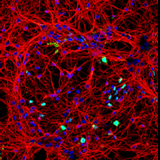A step toward repairing the central nervous system

Despite recent advances in understanding the mechanisms of nerve injury, tissue-engineering solutions for repairing damage in the central nervous system (CNS) remain elusive, owing to the crucial and complex role played by the neural stem cell (NSC) niche. This zone, in which stem cells are retained after embryonic development for the production of new cells, exerts a tight control over many crucial tasks such as growth promotion and the recreation of essential biochemical and physical cues for neural cell differentiation.
According to the first author of the paper, Zaida Álvarez, from the Group on Biomaterials for Regenerative Therapies of the Institute for Bioengineering of Catalonia (IBEC), "in order to develop tissue-engineering strategies to repair damage to the CNS, it is essential to design biomaterials that closely mimic the NSC niche and its physical and biochemical characteristics".
In the study headed by Soledad Alcántara of the University of Barcelona, the team tested types of polylactic acid (PLA) with different proportions of isomers L and D/L, a biodegradable material allowing neural cell adhesion and growth, as materials for nerve regeneration. They found that one type, PLA with a proportion of isomers of 70/30, maintained the important pools of neuronal and glial progenitor cells in vitro. PLA 70/30 was more amorphous, degraded faster and, crucially, released significant amounts of L-lactate, which is essential for the maintenance and differentiation of neural progenitor cells. "The aim of the research was to find a biomaterial able to sustain the population of neural stem cells and to generate new differentiated cells in order to start the development of an implant that allows brain regeneration," explains Dr Alcántara.
"The mechanical and surface properties of PLA70/30, which we used here in the form of microthin films, make it a good substrate for neural cell adhesion, proliferation and differentiation," adds Álvarez. "The physical properties of this material and the release of L-lactate when it degrades, which provides an alternative oxidative substrate for neural cells, act synergistically to modulate progenitor phenotypes", concludes the researcher.
The results suggest that the introduction of 3D patterns mimicking the architecture of the embryonic NSC niches on PLA70/30-based scaffolds may be a good starting point for the design of brain-implantable devices. "These will be able to induce or activate existing neural progenitor cells to self-renew and produce new neurons, boosting the CNS regenerative response in situ," states Álvarez.
Enabling the CNS to regenerate could open doors to promising new strategies to tackle accidental damage as well as numerous diseases like stroke and degenerative disorders such as Parkinson's and Alzheimer's diseases.
More information: Alvarez, Z. et al. (March 2013). The effect of the composition of PLA films and lactate release on glial and neuronal maturation and the maintenance of the neuronal progenitor niche. Biomaterials 34, 9, 2221–2233.














